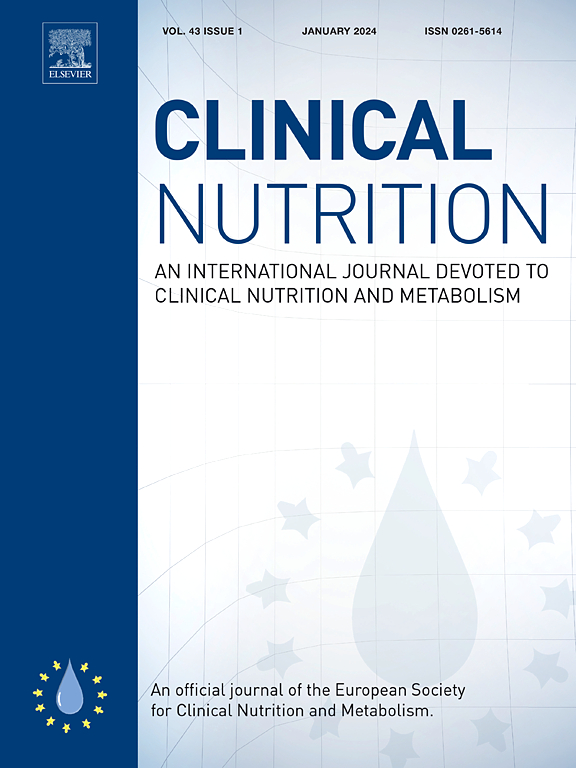6个月和3岁健康足月婴儿骨矿物质密度的决定因素
IF 7.4
2区 医学
Q1 NUTRITION & DIETETICS
引用次数: 0
摘要
背景,生命的前6个月是肥胖发育的关键时期,这也可能是骨密度(BMD)发育的关键时期。然而,目前尚不清楚哪些决定因素与儿童早期的骨密度有关。我们的目标是评估哪些决定因素与6个月和3岁时的骨密度有关,重点关注生命前6个月的生长和大量营养素的摄入。方法采用双能x线骨密度仪(DXA)测定428例6月龄和3岁的健康足月婴儿的人体测量学、骨密度(BMD)、体成分(BMDTBLH),并通过问卷调查收集喂养特征。在3个月大时,使用人乳分析仪测量配方奶喂养和纯母乳喂养婴儿的宏量营养素摄入量。在3岁时,对喂养日记进行大量营养素和维生素D摄入量的分析。采用回归分析探讨BMDTBLH标准偏差评分(SDS)与儿童特征、生长和大量营养素摄入的关系。结果建立了6月龄BMDTBLH的参考值。6月龄体重SDS、瘦体质量(LBM)和脂肪质量(FM)与BMDTBLH SDS呈正相关。相同的变量与3岁时BMDTBLH SDS呈正相关,也与长度SDS呈正相关。3月龄时蛋白质摄入量与6月龄时BMDTBLH SDS呈正相关,3岁时脂肪摄入量与3岁时BMDTBLH SDS呈负相关。结论瘦体重是6月龄和3岁时BMDTBLH SDS的最重要决定因素。3月龄时较高的蛋白质摄入量和3岁时较低的脂肪摄入量与较高的BMDTBLH SDS相关。本文章由计算机程序翻译,如有差异,请以英文原文为准。
Determinants of bone mineral density in healthy term-born children at age 6 months and 3 years
Background & aims
The first 6 months of life are a critical window for adiposity programming, which could potentially also be true for bone mineral density (BMD) development. It is, however, currently unknown which determinants associate with BMD during early childhood. Our objective was to assess which determinants associate with BMD at 6 months and 3 years of age, with focus on growth during the first 6 months of life and macronutrient intake.
Methods
In 428 healthy term-born infants, aged 6 months and 3 years, we measured anthropometrics, BMD total body less head (BMDTBLH) and body composition by Dual-energy X-ray absorptiometry (DXA), and collected feeding characteristics by questionnaires. At age 3 months, macronutrient intake was measured in formula-fed and exclusively breastfed infants using a Human Milk Analyzer. At age 3 years, feeding diaries were analyzed regarding macronutrients and vitamin D intake. Associations of BMDTBLH standard deviation score (SDS) with child characteristics, growth and macronutrient intake were investigated with regression analyses.
Results
Reference values for BMDTBLH at age 6 months were constructed. Weight SDS, lean body mass (LBM) and fat mass (FM) associated positively with BMDTBLH SDS at age 6 months. The same variables associated positively with BMDTBLH SDS at age 3 years, with also length SDS. Protein intake at age 3 months associated positively with BMDTBLH SDS at age 6 months, and fat intake at 3 years inversely with BMDTBLH SDS at 3 years.
Conclusion
Lean body mass is the most important determinant of BMDTBLH SDS at age 6 months and 3 years. Higher protein intake at age 3 months and lower fat intake at age 3 years associate with higher BMDTBLH SDS.
求助全文
通过发布文献求助,成功后即可免费获取论文全文。
去求助
来源期刊

Clinical nutrition
医学-营养学
CiteScore
14.10
自引率
6.30%
发文量
356
审稿时长
28 days
期刊介绍:
Clinical Nutrition, the official journal of ESPEN, The European Society for Clinical Nutrition and Metabolism, is an international journal providing essential scientific information on nutritional and metabolic care and the relationship between nutrition and disease both in the setting of basic science and clinical practice. Published bi-monthly, each issue combines original articles and reviews providing an invaluable reference for any specialist concerned with these fields.
 求助内容:
求助内容: 应助结果提醒方式:
应助结果提醒方式:


